The teacher asked Johnny, “If I give you 2 cats, another 2 cats, then
another 2 cats, how many cats would you have?” Johnny replied, seven.
The teacher asks the question again, and Johnny says, seven.
The teacher then takes a different approach and asks Johnny, “If I give
you 2 apples, 2 more apples, then 2 more apples, how many would you have?”
Johnny replied, six.
The teacher said very good, now let’s try it again. “If I give you 2
cats, another 2 cats, then 2 more cats, how many do you have?” Johnny said,
seven.
The teacher can’t understand his answer and asked him where he got that
number. Johnny replied... I already have a cat.
Do you remember when I said we would talk about Cole a bit more with time permitting... its time.
Our visit today was the Cole Land Transportation Museum.
You can visit their website at: colemuseum.org.
(Courtesy of Cole Land Transportation Museum)
DISCLAIMER: ALL VEHICLES IN THIS MUSEUM WERE DRIVEN IN ON THEIR OWN POWER, WITH EXCEPTION OF THE TRAIN.
Entering the museum Mr. Galen Cole is waiting to greet every visitor.
Coles Express's roots began in 1917, but we will take it back a little further. A.J. "Allie" Cole was a "bound-out boy". For those who have never heard that term, it dates back to a time when families that could not afford to provide for the entire family, would farm a child to someone that was willing to take them. The child would then live with that family. Agreements/contract between the families could range from just providing food, to providing food, clothing, and an education.
In Allies case, his home was a single parent home (mom), and she took in laundry to provide an income. To ease the family burden he left home at age 8. His first family took him in to milk the cows, and do other farm chores, for food only, no clothes.
His second family, the Prebles, also poor, took him in and treated him like one of their own. Allie's chores were to milk the two cows, and take care of the horse. He lived with this family for six years, and four of those years he was able to attend school.
Remember, I said the family was poor, so when Allie went to school, the other children would make fun of his clothes, which was a tattered baseball uniform. He had a love for horses, and at age 14 wanted to runaway with the circus, but Mrs. Prebles talked him out of it.
Because Allie had nothing going for him except determination, was hard working, and honest, he found a job at the local livery stable tending to the horses, earning $6.00 a week and meals. A side duty was to drive salesmen "drummers" to their sales calls. This job was good for him, he made enough in tips from the salesmen, he saved every penny of his wages. Allie was only 14 when he started working there.
By 17 he knew he wanted to do more than drive the salesmen around, usually driving them back to the train station too. This is when he began working at the local train depot, handling luggage and cargo, from 17 to his early 20's.
While working at the train station he met Amy Stone, who was a school teacher for the area. In 1912 they married.
Now we come to the start of Coles Express. In 1917, at age 23 he bid on, and won the contract to deliver mail to the towns around his hometown. Along with delivering mail he began freight service too. The roads were not the most desirable, as they were logging roads that were usually muddy, or covered in four feet of snow.
THE BEGINNING OF A FLEET
By 1917, Allie was married and the father of two children, and that number grew to seven, forcing them to buy a larger house. This was a household where his wife made more money than him, but he was catching up.
Allie grew his business, adding trucks to his fleet. He still had his horses that he loved.
1923 MODEL TT (1 ton)
This Model TT is similar to the ones Allie had in his fleet. Unfortunately these trucks could only be used after the roads dried up, and just until the rainy season started. Trucks like this were too light for the route between Bangor and Enfield, plus they were prone to breaking down.1927 REO SPEEDWAGON
(4 speed transmission, 6,000 pound freight capacity, and carried passengers.)
Allie was driven to achieve as much as he possible could, one way was to expand his business, but in some areas of Maine that was difficult to do during the winter because the Department of Transportation (DOT) didn't plow roads in the rural areas heading north. Allie asked them to, but they declined, so he took it into his own hands, plowing the roads himself.
In the beginning he might have used equipment similar to this one:1939 INTERNATIONAL TRACTOR W/SARGENT PLOW
This one on exhibit was originally bought by the town of Gloucester, ME for $6,130.00. The price tag included the side wings. Believe it or not, this snow plow was used in the 1969 blizzard. The maximum plowing width was 17 1/2 feet.
Let's finish the Coles Express story first before we visit the rest of the museum.
Because of Allies determination, future winters, roads in the rural areas were plowed by the DOT.
Always trying to ensure safety for his drivers and guarantee delivery, the vehicles speeds were limited to 20 mph. The top speed for these trucks was 35 mph.
Times changed, and so did his fleet of trucks. His company was now servicing all of Maine, New England, down to the Virginias, and over to Ohio. During WWII he needed to be resourceful to continue running his business, and this involved finding ways to build more trailers with scrap metal since metal production was focused on the war effort. He also understood that making a delivery one-way was lost of profit when returning home, so he modified part of his fleet of trucks (this occurred later).
In 1958 the Cole Express look changed1958 DIAMOND "T"
Coles' fleet consisted of 20 of these. The Detroit diesel engine was both powerful, and serviceable. This diesel engine did not require overhaul until around 100,000 miles, where the previous engines required overhaul between 60 and 70,000 miles. Its freight capacity was 60,000 pounds, with a top speed of 60 mph.
FUN FACT: if you look closely to the 1958 Diamond T photo, the trailer in the background is one that Allie build from scrap metal.
Earlier I talked about Allie understanding the loss of profits when delivering one-way, this is how he solved that issue.1964 GMC CABOVER
The tank behind the cab held between 3,300 and 3,900 gallons of fuel, the trailer could carry 12,000 freight. There were four of these trucks in his fleet.
During the winter months the trucks ran twice a day between Bangor, Presque Isle, and Caribou delivering fuel, the trailer was empty. On the way back south after the fuel was delivered, the trailer would haul potatoes or paper products. He did this from 1963 to 1969, then OSHA shut him down because the tanks began to leak.
1970 DIAMOND REO CABOVER
These trucks were brought into service in 1970. These trucks were used for over-the-road service between Boston and Aroostook County, ME. This particular truck, #462, logged 1,040,990 miles in ten years of service. When it was removed from the fleet, it was still in excellent operating condition. The 1970 Diamond REO had a freight capacity of 80,000 pounds, and a top speed of 64 mph.
The run was good, but by 1992 it was time to move on to other adventures, and Coles Express was sold to Roadway. The Cole family is still very involved with their community and state.
The name of this museum is the Cole Land Transportation Museum, so lets see other land transportation.
********** YOU HAVE NOW BEEN RELEASED TO A BATHROOM AND REFRESHMENT BREAK. **********
Galen Cole, the founder of the museum had a love of many things, one of them trains like many of us, so yes there is a train in the building.
With that being said, which came first... the train... or the building?If you said the train, congratulations, you were correct.
The locomotive was no longer accessible, and I forgot to photograph the box car. The boxcar had displays inside it, and a video presentation.
While we are on the subject let us visit a train station.
This was a portion of the Enfield, ME train depot that Allie worked at. The train service was being discontinued and the railroad was getting rid of the depots, either by burning them down, or dismantling. Allie asked the railroad if he could have the Enfield Station.
The railroad agreed and he dismantled it and moved to their trucking yard, where it sat covered until it was moved to the museum, and installed in one of the corners of the building.
Have you ever wondered how the New Englanders handled their roads in the early days, let me show you...SNOW ROLLER
This piece of machinery was used in the early 1900s before the snow plow. Under the wood planks are four iron wheels on two axles, each axle had two wheels. The roller was pulled by as many as four teams of horses, it all depended on the density and depth of the snow. With the snow compacted it made it easier traveling for horses and sleighs. The one drawback was the icy road during the spring thaw.
SIDEWALK ROLLER
These rollers were also used to level out sidewalks after the spring thaw, as well as compact the snow on sidewalks during winter. Used in the early 1900s, and pulled by a horse or two.
1952 SNO-CAT
This SNO-CAT served the Maine Public Service Company from 1952 to 1999, accessing off-road and remote sites for maintenance and repairs of their transmission and distribution equipment. It could accommodate six men and the lineman equipment.
In 1963 it was used to save a person stranded in a plane crash, and again in 1969 to save a couple of TV station technicians working in their remote distribution system building.
In 1999 it was retired from service due to unavailability of repair parts, so it was donated to the museum.
1926 MODEL TT SNOWMOBILE
This Model "TT" was fitted with a snowmobile attachment that was invented in 1913, and went into production in 1922. These trucks were sold as being able to go where no sleigh or horse could. The manufacturer of the attachment boasted that it would "Put a Ford on snowshoes". These truck were most popular with mail carriers and doctors. This particular truck was found on a farm. The farmer used it in the winter as his utility vehicle in the 1920s, then it sat for 60 years idle in a field. Fortunately someone came along and bought it, then gave it to a person that restored it to its present condition.
CAROL REMINISCING ABOUT DRIVING HER FIRST CAR
(Notice her current loaner to the left)
It was neat that the museum had walkers, strollers, and wheelchairs available for visitor use.
1932 REO ROYALE SPORTS COUPE
This was Allie Cole's personal car, which he took on business trips. There were only 172 of theses car produced, and only 12 are believed to still exist. While this is a coupe, two more passengers could ride in the rumble seat. This car was a go getter with an 8 cylinder engine, four-speed transmission, and the ability to hit 90 mph.
1954 PAVING ROLLER
This guy was built in 1954 and used in multiple states in the New England area, finally settling in Maine in 1967 where it worked until 1970. The weight of this machine came in at 31,010 pounds, which included the 399 gallons of water used as ballast. If you ever wondered why it took so long to get roads paved, this machine was a six cylinder, 72 hp engine, with a top speed of 5 mph. It became part of the museum in 1989.1955 MACK D-42
This truck was well like because of its short wheelbase which made it quite maneuverable in tight spots; the wheelbase is only 96 inches. It was originally fitted as a freight tractor, then later retrofitted for carrying coal.
For you east coasters out there I'm sure you are familiar with the use of coal for warming your homes. Part of the retrofitting was the scissor jacks that allowed the coal to be dumped down the coal chutes at businesses or homes with easy access.
If you look closely to the left side of the photo, there is a yellow circle. In that yellow circle is a bag used to get coal to homes and apartments without coal chute access. This of course meant many trips in some cases.
This is for that do-it-yourself kind of person.
1942 MACK CONCRETE MIXER
Originally owned by a Rhode Island company in 1942, it was sold to a concrete company in Maine, in 1958. It was used in Maine until 1965, when it went into retirement. The Dragon Products company who owned it, restored it and donated it to the museum in 1989.
Here we go, a small trip back in time. We traveled to an era that saw many mobile businesses, including healthcare. I present to you... MOBILE DENTIST/OPTOMITRIST OFFICE
We are proud to show you Dr. Mansfield's portable dentist office. He graduated from dental college in 1890, and started his practice in Jonesport, ME. He took it on the road several times a year to remote locations, advertising with handbills, just like the circus would. In the beginning Dr. Mansfield charged 25¢ for a tooth extraction, and $12.50 for a set of dentures. One of his prize possessions was he wedding ring he made out of the gold retrieved from extracted teeth.
Later on he received a degree in optometry, and added that equipment to his wagon. Dr. Mansfield practiced dentistry for 70 years, and stopped practicing at age 92. He died at the age of 98, probably missed doing what he loved.
This next exhibit is a two-parter. A gentleman by the name Don owned a camper business, hence this photo.
This truck actually pulled this trailer in the day. The more interesting of the two is the "camper".
This camp trailer was manufactured in 1925, at a cost of $348.00. They definitely built like today's models. The wheels are "wood artillery wheels" on Timkin bearings and Model T tires. The springs and tires were interchangeable with Model T parts. The body and frame are made from 24 gauge steel and basswood. The weight of this trailer is 900 pounds, which includes the stove, stove hood, ice box, beds, and full length benches. This guy saw use in the summers from 1946 to 1961, averaging 1800 miles a year.
Carol and I didn't realize how many acres of farm land sprout potato plants, there are a lot of potato farms up here.
Technology has come a long way since the early 20th century.
CHAMPION MODEL 1-DR46 1/2R POTATO DIGGER
(ca 1906)
POTATO DIGGER (ca 1890)
(Horse drawn; the hills were dug up and the potatoes were windrowed*, increasing the efficiency of the pickers.)
* Windrowed - separated the potato from the plant.
VICTOR POTATO DIGGER (ca early 1900s)
(Designed to "throw" potatoes between rows,
combining two rows.)
After the potatoes were picked up, they had to go somewhere, right?
The pickers would grab a wicker basket and collect potatoes, then dump them into a barrel. The pickers were assigned a number, and for a good reason, they got paid by how many barrels they picked. How did the farmer know how much to pay each picker, each barrel had a picker's number attached to it.
The barrels started on the ground, when filled, the barrel would be lifted to the truck bed. Technology improved the process for getting the barrels on the truck, a hoist was installed to the bed of the truck for raising the barrels.
Galen was a lover of fire engines, so there is a collection of them here. Here are a couple of them.1923 AMERICAN LA FRANCE CITY LADDER TRUCK
This truck was purchased in 1923 and saw service until the late 1950s. As you might be able to see, it carried hooks, ladders, life net, and tools to the scene. Every tool had a storage space, and the shovels could be found under the running boards. It also carried lanterns for safety during night events. It did not retire in the late 50s, it was turned into a training unit for the Job Corp.
1930 AMERICAN LAFRANCE LADDER TRUCK
This truck supplied extra ladders and hoses for a fire. There were 238 feet of extension ladders, a 1,000 feet of 2 1/2 inch hose, a booster tank and lines, with a 1,000 GPM pump.
The next exhibit was one of the least efficient modes of travel...1913 STANLEY DELIVERY TRUCK
The driver needed to ensure that there was 120 psi in the Prest-O-Lite tank, enough water in the boiler, make sure the acetylene torch worked. Now lift the hood and smoke bonnet lid, open the Prest-O-tank valve, light the acetylene torch with a match, place the torch so the flame strikes the pilot vaporizer...
It took five to fifteen minutes to get the water temperature high enough to create steam. Don't forget to check your water level periodically, or run out of acetylene.
Now we will completer the circle. If you remember, I started out with the snow roller, now we are going to look at improved technology... the snow plow.
1933 CLETRAC* MODEL 80 WITH SARGENT PLOW
*Cletrac stood for Cleveland Tractor Company. This tractor purchased new cost $8,300.00, and was the largest model the company made. No parts have been replaced on this machine, so you see it as it was sold in 1933. There was one disadvantage to this monster... with a 100 gallon fuel tank... it got 4 GALLONS to the mile, in other words, could only plow 25 miles of road before having to fill up again. With the side wings out it could plow a 22 foot path, which is the length of our truck.
If you look closely at the lower photo you can see handwheels atop the blades, these were how the men manually set the blades. Did you catch the word "men". It took four men to operate this plow, one driving, three to adjust the blades. It was better than shoveling.
1935 LINN TRACTOR WITH FRINK PLOW
This plow ran $7,00.00 in the mid-30s. Like the previous plow, it originally took four men to operate it, however, one of the owners made some modifications. The owner build a wood shelter on it and added controls for the blades to be operated from the inside, now it only took two men to operate the plow. This plow was capable of plowing 28 foot swathes in the snow. This plow was in service from 1935 to 1969.
VIEW OF THE WOODEN CAB ADDITION
VIEW OF THE TRACKS ON THE PLOW
The 1940s saw a change in the way snow was plowed.
1940 FORD TRUCK WITH A SARGENT PLOW
This truck has tandem rear axles, both of which are driving axles. When it wasn't winter the truck was used for general maintenance, and road repairs. The plow is not just mounted on the bumper, it extends back down the chassis frame to behind the cab, this was where it got its pushing force from. As you might see the width is much narrower than the big guys, it only plows a swathe 12 feet wide.
1952 OSHKOSH TRUCK WITH FRINK PLOW
Bet you thought Oshkosh only made children's clothes.
The state of Maine bought this machine for a measly $18,650.00; they didn't keep it long. In the 1960s it found a new home plowing snow for a Ripley, ME contract. 1969 was a tough year for this plow and crew. During the blizzard of '69 they worked 48 straight hours, in winds ranging from 50 mph to 100 mph.
For most of the people not from snow states, or countries, snow is not what it looks like, light, fluffy, snowball makin' material, it can be hard on equipment. It can be heavy and dense depending on its moisture content. Look at the left side of the blade and notice the deformation. This deformation was where the snow actually tore the blade, requiring a weld job to repair it.
The last plow is not a plow... its a blower.1931 FWD TRACTOR WITH A 1937 SNOGO BLOWER
You people in California thought this was your idea for removing snow... HA. This blower was first used in Iowa before a gentleman from Maine bought from them. There is a story behind this blower, and here goes...
When the gentleman first used the blower it worked great removing snow from its path, sending a plume of snow high in the air, however there was one thing he didn't know was happening, but would soon find out. While he was blowing this snow there was a man in the street waving his hands like he was excited to see this new machine in action, but that wasn't the case. When the owner/operator stopped to speak with the man he learned that the large plume of snow he was sending into the air, was breaking windows in people's homes. From that day on this machine sat as back-up, that machine you look for in case the other one breaks.
This is one of the largest snow plow exhibits in the United States.
You have heard of the "coat of many colors", well here is the "bus of many purposes".1933 MODEL 712 17 PASSENGER BUS
It started its life in Pennsylvania before making its way to Maine in 1942. It operated as an intercity bus from 1942 to the 1950s in Sanford, ME. The next tour of duty was working with the Chesterville Fire Department, and a youth group from Jay, ME, as a lunch wagon. Lunch service was discontinued in 1970. It sat in the Jay Hill museum waiting for restoration that never happened. It was sold to a father and son business who restored it and donated it to the museum.
TAKE A BREAK, I'M GOING....
The last portion of the museum is a tribute to all the veterans that served in wars to protect our freedoms. Galen Cole was a veteran himself, receiving the Purple Heart, among other medals.
Here is a question for you, look at these two pennants, do you know what they represent?
The pennant on the left was hung in windows of homes that had someone that went off to fight. It had as many stars on it as persons who left to fight. The pennant on the ride hung in windows of homes that lost someone in the war, again it would contains as many stars as fallen service members.
The biggest story of loss that may come to mind for many, has to do with the Sullivan family during the war. Five Sullivan brothers enlisted in the Navy, and at that time siblings could be stationed together. They were stationed together on the USS Juneau (CL-52). The Navy lost the ship, the family lost all five sons, their pennant displayed five stars. It was the worst loss for any family during the war.
I remember joining the Navy, I had to sign a statement that I was the only child of my parents. Years later I would be telling young men and women the same thing when I was a Navy recruiter. The services no long station siblings at the same duty stations, except under special circumstances.
I have showed you one of these before...
The U.S. government all regular money in Hawaii, and re-issued stuff printed with the word "Hawaii" on it. This was done in case the Japanese captured the islands.
He also has uniforms from different years that we given to him.
One section is dear to him, and he wanted to memorialize his outfit he was assigned to, Army, 5th Armored.
GERMAN 88MM SHELL
US ARMY HALF-TRACK
What do these two photos have in common... I will tell you.
Galen Cole and his fellow soldiers were traveling in a half-track much like this one when an 88mm shell came through the windshield of the vehicle, killing the driver, passenger, and most of the soldiers in the back of the vehicle. Galen Cole was sitting at the back, but was injured as well. After he recovered from his wounds, he went back into the field of action.
This memorial is for those in Army 5th Armored that gave the ultimate sacrifice. Galen hosted a reunion for the survivors yearly.
HISTORY LESSON:
Outside the museum are several monuments to Maine veterans. There is a "Huey" helicopter:
I didn't realize how much use these aircraft got. They were used for MedEvac, as gun ships, command & control, air assault, and transporting of personnel and materials. In 1963 there were more than 7,000 operating.
This new form of transportation changed the life of a soldier on the ground. In WWII, in the South Pacific, a soldier saw an average of 40 days of combat in four years. With the Huey, the Vietnam soldier saw an average of 240 days of combat in one year.
The ceiling on these helicopters was only 14,200 feet, which made them vulnerable to gunfire. Many of their missions held them to lower altitudes. Despite the hazards, 9.7 million flight hours were recorded. In those hours MedEvac missions consisted of 500,000 missions, carrying 900,000 patients, nearly half of them Americans. Because of quick transport times, less than an hour, less than 1% of the American soldiers who survived the first 24 hours died.
There was a cost for saving lives and the duty of gunships. During those recorded 9.7M flight hours we lost over 3300 helicopters, 1,074 pilots, and 1,103 crew members.
Continuing down the path we came to a vehicle that apparently received permission to park in the area.M60A3 TANK
The M60 was an improvement to the M48 Patton Tank. 15,000 M60 tanks were produced and they are/were used by 22 countries.
During Vietnam the Army used the M48 tanks for their assaults, while the Marines used the M60 at stationary positions. With all the modifications to the M60, it was phased out in 2005, in favor of the newer M1 Abrams tank.
END OF LESSON.
On the other side of the lawn was the memorial honoring WWII, Korean War, Purple Heart recipients, and Maine servicemen awarded the Congressional Medal of Honor.
We must always remember that: FREEDOM IS NOT FREE.
When I joined the Navy I understood that I was going to protect the interests of the United States, and memorials like this remind me that "freedom" is one of those interests.
I'll tell you one little secret, the museum visit and the memorial visit were different days. The day we visited the museum the first time, it decided to rain while we were in the museum, and looked like it wanted to do it again when we left. The second trip was a bright sunny day, and only I went.
Another venture out was to find Paul Bunyan. The funny story about finding him... we had driven by him several times and never noticed him. Without further ado, here is Paul Bunyan in Bangor:PAUL BUNYAN IN FRONT OF THE HOSPITAL
I know all six of you out there read, you're looking at my post. Who knows of a famous writer from Maine? I'll give you a hint:
Have you figured it out? This is Steven King's first home before becoming super famous. Today it is occupied by the Steven King Society, so there is no touring the inside.
If you look closely at the wood carving, you will see that it is made from the old tree, much better than cutting it down all the way to the ground.
We will continue on with Maine in our next post.
ITS OK TO LAUGH
I never wanted to believe that my day was stealing from his road work job, but when I got home... all the signs were there.






















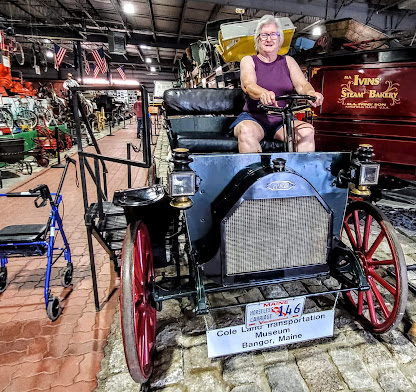







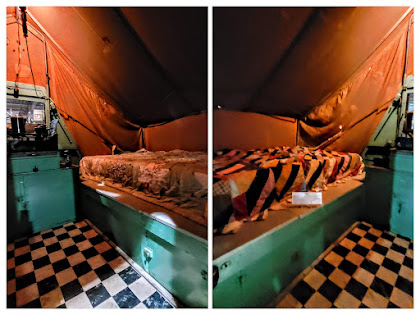







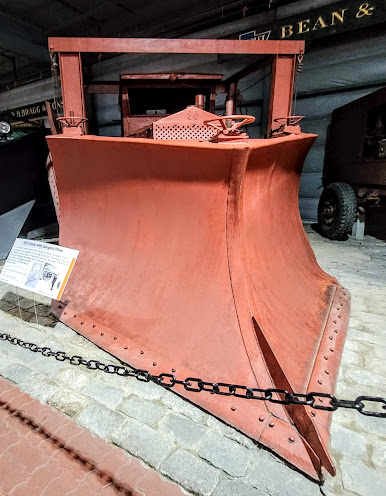

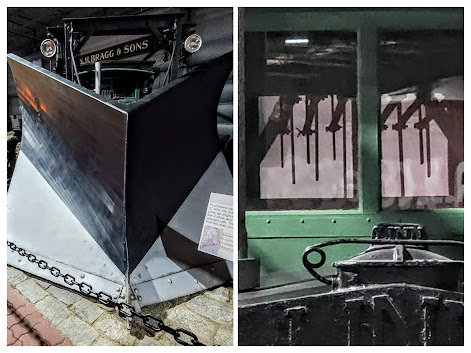
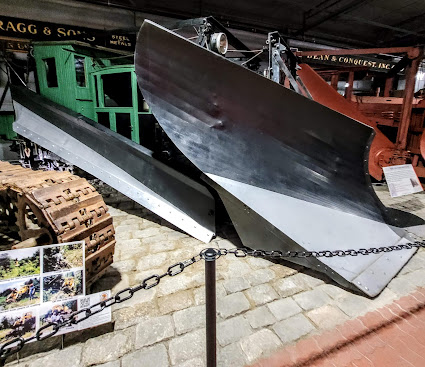



















No comments:
Post a Comment